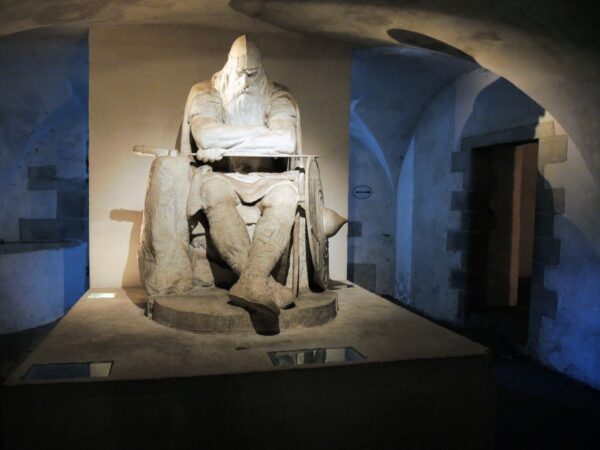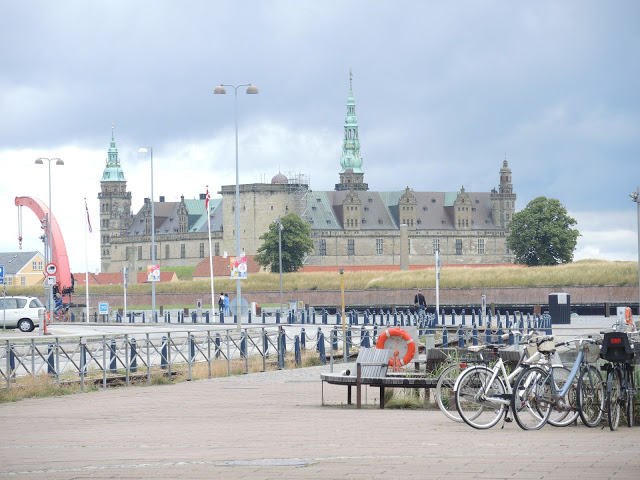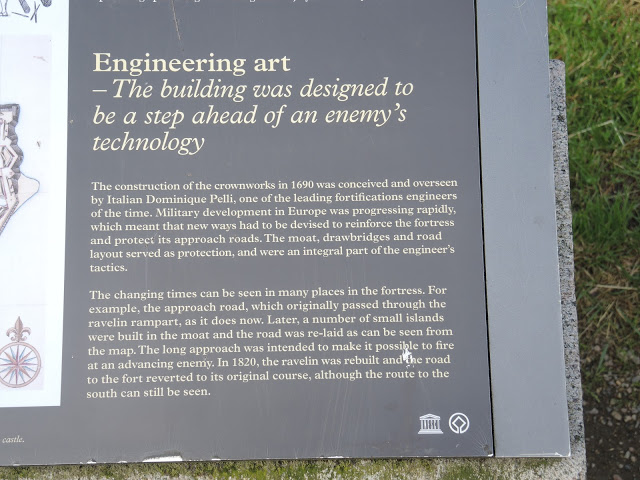At the end of the previous entry, I asked you, dear reader, to think about why I might visit Helsingør which is about 40-minutes by train from Copenhagen. Have you made the connection?
If you have, congratulations. If not, the first hint is in the headline for today’s entry. And if you’re still in the dark, drop the ‘h’ and soften the ‘g’ when you pronounce it. Got it now? Well, Helsingør becomes in English Elsinore “home” to the most famous melancholy Dane of all. Let’s put some pieces together, shall we?
You might remember that in a previous post, I noted that all Danish kings bear either the name Christian or Frederick. However, this rule applies only to the house of Oldenburg which began with the reign of Christian the First in 1448. The only king not bearing one of those two names since then was Christian the First’s successor, his third son, John.
Next we turn to Shakespeare who was born in 1564 and produced most of his writing beginning in 1589. Kronborg was a fortress first built in the 1420s on the Øresund – a body of water known in English as The Sound. Over 11 years in the last quarter of the 16th century Frederick II expanded Kronborg into a Renaissance castle that was among the largest and most unique in appearance in Europe. So, by Shakespeare’s time, Kronborg Castle in Helsingør would have been widely known.
Hamlet himself was likely based on Ameleth the son of a legendary Jutish king, Horwendill. (It’s also possible that Shakespeare named the character for his lone son with Anne Hathaway – Hamnet who had died three years earlier and whose name would have been pronounced like the character’s.)

[Amblett – 17th Century Danish Illustration – from Wikipedia – Public Domain.]
The Jutes came out of Jutland and invaded and conquered what is now England in the fourth century. So their history would have likely been known to Shakespeare. From a historical standpoint, however, we have to note that Jutland occupied much of what is now the mainland of modern Denmark and not the western lowlands near Copenhagen and Helsingør.
So, like any good historical novelist, or in this case, playwright, Shakespeare took some pieces of history and legend and conflated them for his dramatic purposes. Did Hamlet truly exist? probably not. If he did would he have been at Kronborg Castle in Helsingør? Certainly not. Does it matter? Absolutely not. All that matters is that Shakespeare created a masterwork for the ages and set it at Helsingør. And both Helsingør and Kronborg know and celebrate the connection. And we can, perchance, dream as well, can’t we?
A quick tour of Helsingør
So how did my day go? It started with a walk to Eastport train station where I hopped on the train for the 40-minute ride up the Danish coast to Helsingør. I stepped out of the station there and saw this:.
Kronborg (Crown Castle) is a UNESCO World Heritage Site. As I wrote above, a fort has occupied the site since the early 15th century but it was the expansion initiated by Frederick II that elevated the castle to one of the most important in Europe. In part, the site was chosen to collect tolls from ships wanting to pass through The Sound into or out of the Baltic Sea. However, it also served a defensive purpose. The Swedes are just four kilometers away.
Part of Frederick II’s expansion in the period from 1574-1585 was to modernize the fortifications. He extended the bastions in 1577 and, even in the 16th century, warring powers were engaged in an arms race of sorts. Kronborg was constantly re-engineered.
Inside the walls of the fortress, the castle was expanded to contain chambers for the king, queen and her ladies-in-waiting, for the chancellery on the north side, and a chapel on the southeast side. The third story was first added to the south side followed by the west and north sides and finally the east side. Part of this project included the construction of the Grand Ballroom – a full 62-meters long – on the south side above the chapel.
Nearly the entire castle burned in a fire in 1629 with only the chapel surviving the conflagration. Even at this date, King Christian IV recognized the importance of not just the fort on the site but the castle as well and oversaw the reconstruction of the buildings. The entire project required nearly a decade and reconstructed the exterior of the castle without major changes. The same could not be said of the interior with the Baroque architecture replacing the original Medieval.
In the casemates of the castle is a statue of Holger Danske or Ogier the Dane. Now I can hear you wondering, what’s a casemate and who’s Holger Danske. Well, I’m a full-service writer and will happily answer both questions. A casemate is a vaulted chamber constructed under the ramparts of a castle. It’s very dark and meant to be impenetrable. In the case of Kronborg, the casemates are extensive. In fact, in appearance, they’re quite like catacombs.
As for old Holger, he was a legendary Danish warrior and knight in Charlemagne’s army. He first appears in the Chanson de Roland, one of the principal works of medieval French literature. The legend has it that he never lost a battle in his life. However, he got increasingly homesick, and finally decided to walk from the South of France and Emperor Charles’ court, back to Denmark. Upon his arrival he sat down and went to sleep where he remains to this day. He was later a subject of Hans Christian Andersen who wrote,
Holger Danske sits in the deep, dark cellar, into which no one goes. He is clad in iron and steel, and rests his head on his strong arm; his long beard hangs down upon the marble table, into which it has become firmly rooted; he sleeps and dreams, but in his dreams he sees everything that happens in Denmark. On each Christmas-eve an angel comes to him and tells him that all he has dreamed is true, and that he may go to sleep again in peace, as Denmark is not yet in any real danger; but should danger ever come, then Holger Danske will rouse himself, and the table will burst asunder as he draws out his beard. Then he will come forth in his strength, and strike a blow that shall sound in all the countries of the world.
Hotel Marienlyst in Helsingør commissioned a bronze statue of Holger in 1907. The sculptor, Hans Peder Pedersen-Dan, made a large plaster cast for the statue, the original of which now sits in Skjern in Jutland. The plaster cast was originally placed in the casemate at Kronborg but moisture took its toll and the plaster was replaced by the stone statue we now see. In the statue he is portrayed as a sleeping giant with his arms folded over his sword prepared to awake and do battle if the kingdom of Denmark is ever threatened.

On a side note, Holger Danske was also the name of a group of Danish resistance fighters in World War II.
Because I had to be back at the hotel by two thirty to muster for the bus that would take our group to the ferry terminal for the overnight trip to Oslo, my visit to Helsingør had to be rather brief. The ride back on the train was as easy as the ride out of town and the day passed without incident. My next report comes from Oslo.



What a great history lesson. I am glad that I will not have a test when you return.
Thanks.
This blog is an incredible resource for anyone looking to expand their knowledge on a variety of topics. The author’s writing is both informative and engaging, and their ability to present complex ideas in an accessible way is truly impressive. I appreciate the level of research that goes into each post, as well as the author’s commitment to providing balanced and unbiased perspectives. What I love most about this blog is its ability to make even the most complex subjects approachable and interesting. Whether you’re a casual reader or a serious scholar, there’s something here for everyone.
Thank you so much for your kind and thoughtful words